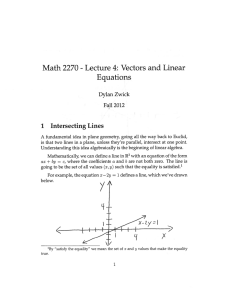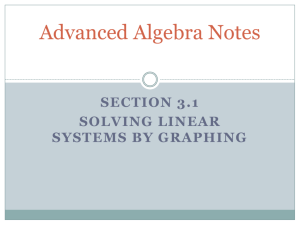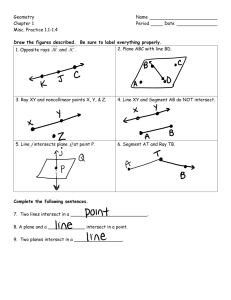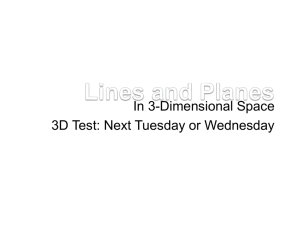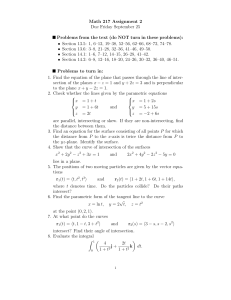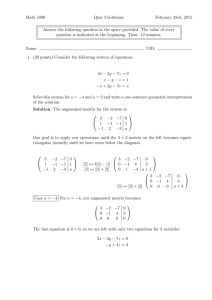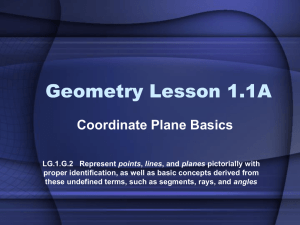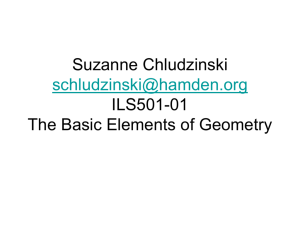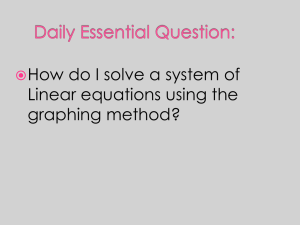Math 2270 Lecture 4: Vectors and Linear Equations 1
advertisement
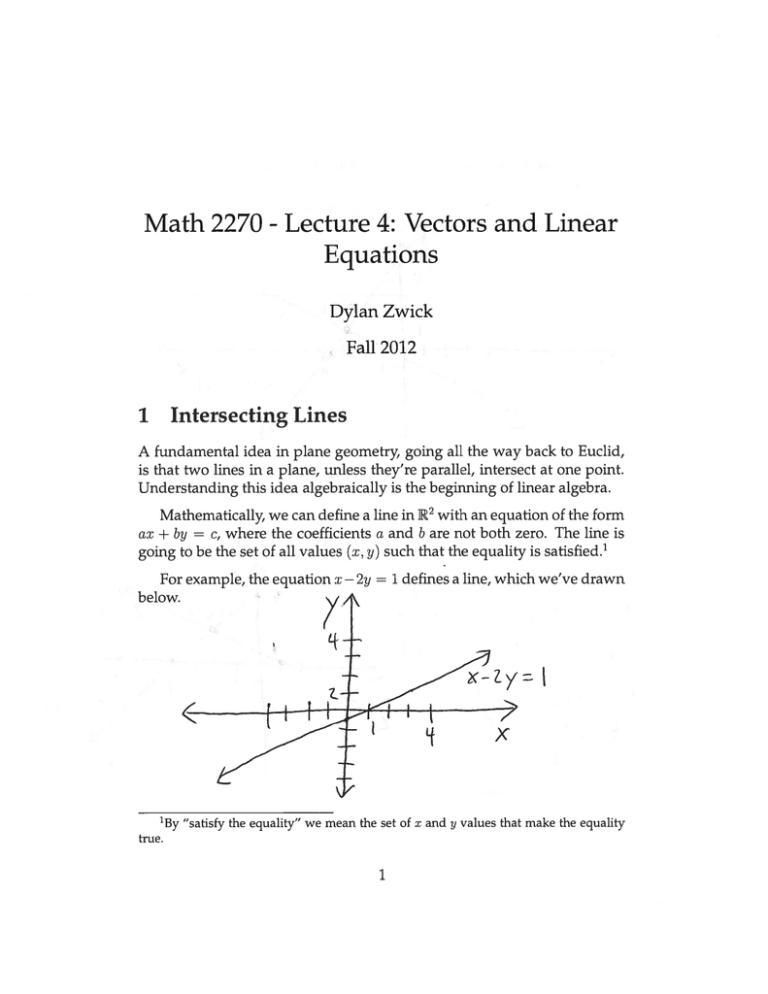
Math 2270 Lecture 4: Vectors and Linear
Equations
-
Dylan Zwick
Fall 2012
1
Intersecting Lines
A fundamental idea in plane geometry, going all the way back to Euclid,
is that two lines in a plane, unless they’re parallel, intersect at one point.
Understanding this idea algebraically is the beginning of linear algebra.
2 with an equation of the form
Mathematically, we can define a line in R
ai + by = c, where the coefficients a and b are not both zero. The line is
1
going to be the set of all values (x, y) such that the equality is satisfied.
For example, the equation
below.
—
2y
=
1 defines a line, which we’ve drawn
7,
=1
1j
x
‘By “satisfy the equality” we mean the set of x and y values that make the equality
true.
1
Every point on the line
2 satisfies the equality, while every point not on
the line
3 does not.
4
Now, let’s take a look at another line, the line 3x + 2y
11. We’ve
drawn this line below, along with our earlier line defined by x
1.
—
The two lines meet at a point, (3, 1), and this point corresponds with
the only values of x and y (x = 3, y = 1) that satisfy both equations.
Example
intersect?
-
At what point do the lines x + y
xy
=
4 and 2x
=
—
—2
C)
(z,
L)
Lj.
x=2
2
F
or example the point (3, 1).
For example the point (0, 0).
3
A fancy mathematical way of saying this is that the line is the
4
ing the equation.
2
locus of points satisfy
Example At what point do the lines x + y
-
=
4 and x + y
12 intersect?
{-y
)‘ t
y
.7
ftc)
(1h
)14e5
af€
prc((eH
Now, what does this have to do with vectors? Well, we note that we
can combine the two equations that define our lines using vectors, and
write them as a linear combination.
We can write:
¶2y
x
3x + 2y
—
1
11
as
/ 1
2
3
We’re looking for the values of x and y that satisfy the above equation.
Another way of putting this is, we’re looking for the linear combination of
the first two column vectors that equals the third. In this case, there’s only
one, and that’s the linear combination we get when x = 3 and y = 1. We
can view this graphically as:
:1
2
When Two Lines Intersect At a Unique Point
Now, suppose we have two lines ax + by
p, and cx + dy = q. Here
a. b, c, d. p. q are real numbers. We know from geometry that the two lines
intersect at a unique point if and only if the two lines aren’t parallel. If
5 The slope
the two lines are parallel, that means they have the same slope.
of the first line is —a/b, while the slope of the second is —c/d. If the two
slopes are equal then:
—a/b = —c/d
ad = be
=ad—be= 0.
We won’t be fastidious here and worry about whether b
5
0, although we probably
should be. Just know that our final statement about the determinant is true even if b = 0,
but this requires a little more bookkeeping.
4
So, the two lines intersect at a unique point if and only if ad
—
bc
0.
Going back to our vector equation, we can view the problem of figuring
out the point of intersection as the problem of figuring out the x and y
values such that
1a
1b
Ip
We can rewrite this yet again in terms of matrix multiplication as:
(a b(x(p
c d)y)q
( ).
The problem of finding our point of intersection becomes the problem
of finding the input vector
( )
that gives us the ouut vector
In lecture 3 we learned this was only possible if the coefficient matrix is
invertible. We just learned this is also only possible if ad bc 0. So, the
coefficient matrix is invertible if and only if ad bc 0. We call the number
ad bc the determinant of the coefficient matrix. Much more on this later.
—
—
—
3
Intersecting Planes
Two planes will, unless they’re parallel, intersect along a line. A plane and
a line will, unless they’re parallel, intersect at a point. So, three planes will,
6 intersect at a point.
usually
3 is represented by an equation of the form ax + by + cz = d,
A plane in 1R
where a, b. c, d are constants and it’s not the case that a = b = c = 0. The
plane will be all the values of x. y z that satisfy the equation.
6
W
e can make the term “usually” mathematically precise, by saying outside of a set
of measure 0, but I think it’s clear what I mean here by “ususally”.
5
Example Calculate the values of x, y, z that satisfy the three linear
equations below:
-
r
2r
6r
+
+
—
2y
5y
3y
+
+
+
)( ‘-YIL
v=
/
=
=
6
4
2
y
9-’6
(u-Ui)
—
I5
9
-4
3z
2z
z
77
:i3
-
f37(,_
77=
We just calculated the point where the three planes defined by the three
equations above intersect. We’ll talk more about intersecting planes in
lecture 5.
6
